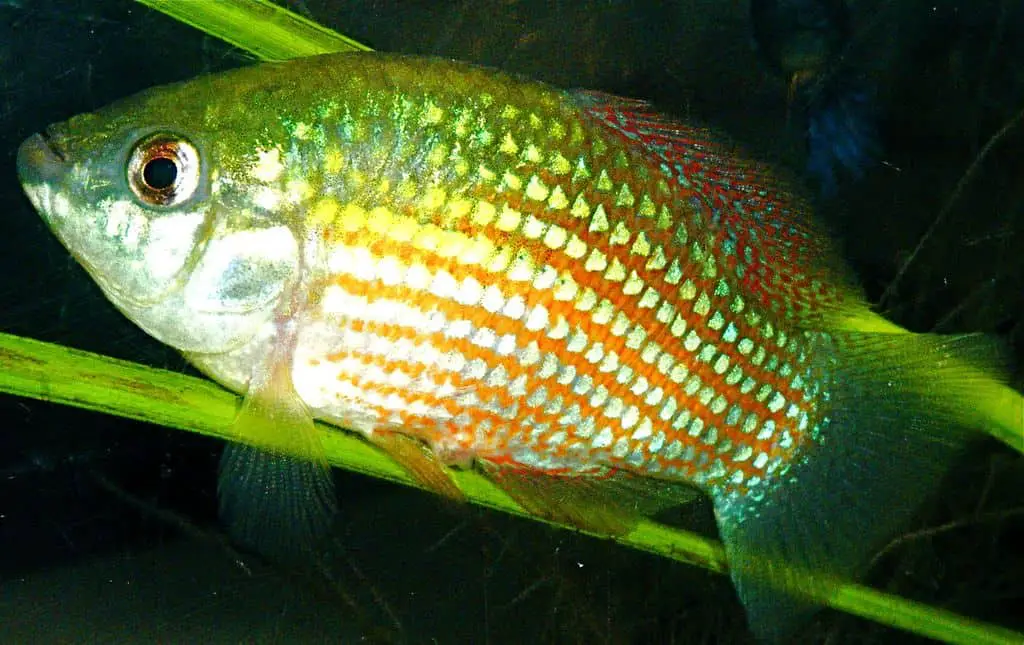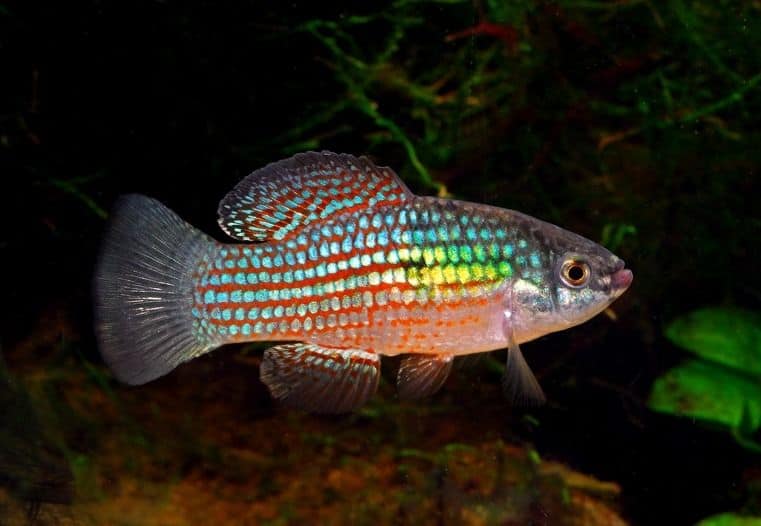The American Flagfish (Jordanella floridae) comes from slow-moving marshes, swamps, lakes, and ponds in North America, Florida to through to the Yucatan Peninsula.
It gets its name from the colors and patterns on the flank of the male fish during the breeding period. It bears a remarkable resemblance to the Stars & Stripes on the USA Flag.
This fish will add some color to your cold water fish tank, giving you another variety of cold-water fish in your aquarium.
They are part of the Killifish family (Cyprinodontidae) which are often found in Tropical Tanks and loved my many hobbyists for their striking colors like the amazing Freshwater Tropical GARDNERI PANCHAX KILLIFISH
Let’s dive right in and look in-depth at the American Flagfish
| Scientific Name | Jordanella floridae |
|---|---|
| Common Name | American Flagfish |
| Origin | Florida |
| Water Type | Cold water Fish, ponds |
| Size | 6-7 cm Max |
| Temperament | Peaceful |
| Water Conditions | 18-24°C, 5-20 dGH, 6.0-8.0, |
| Tank Size | Pond or 70 litre tank |
| Cost | $7-9 |
Table of Contents
Where do American Flagfish come from?
These wonderful fish can be found in Florida, south to the Yucatan Peninsula, where they live amongst the marshes, rivers, floodplains, and ditches.
Now mostly captive bred in fish farms they are found in pet stores and aquariums worldwide.
Are American Flagfish suitable for cold water tanks?
YES, They make great coldwater fish where their beautiful colors can be admired close up. They’re also suitable for smaller ornate ponds but you won’t get to see their colors in a pond as much as you would in a tank.
American Flagfish loves to eat algae and they make quick work of hair algae. So many people used these fish as a way to keep algae down in your aquarium.
They will nip and eat other plants in your aquarium so make sure you have plenty of vegetation for them to eat and supplement their diet with algae tablet. We buy ours from Chewy.com as we find them great value for money and they offer fast delivery. This will reduce the number of plants they eat in your tank.
American Flagfish are perfect for community aquariums, planted aquariums, cool-water aquariums. Ensure you provide plenty of plants and shaded areas. They also need a gentle flow of water throughout the tank, not too much as they come from slow-moving streams and marshes in the wild.
Males can be semi-aggressive and you’ll need to have a tank with some open space for them to swim freely. If the tank is overstocked they can become territorial. So providing shelter and planted areas is very important.
We would highly recommend the American Flagfish for a cold water home aquarium. There are many fish that can make your tank look bright and colorful but none more so than these stunning fish.

Tank Requirements needed
American Flagfish is very hardy and will adapt to most environments. Housed in fish tanks or pond they will thrive providing the correct water conditions are provided.
We would recommend a tank of at least 10-15 Gallons just in case you get a male that’s a little territorial, then they have space to get out of trouble and allow the other fish to escape.
But don’t let that put you off buying one of these amazingly attractive coldwater fish. It’s a very hardy and peaceful fish.
To bring out the fantastic colors we recommend darker colored gravel and bright lighting. This will enhance and show off their colors.
We recently saw a fantastic cold water aquarium in a hotel and they had used Black Frosted gravel. We found some for sale on Chewy.com.
You may be surprised to learn that American flagfish actually make great aquarium cleaning fish as they love to eat hair algae. Read our complete blog on aquarium cleaning fish for more information.
Feeding American Flagfish
The American Flagfish will accept most live foods such as brine shrimp, white worms, tubifex. These should be given once or twice a week but not every day as they are very high in protein which is too much quantity can be harmful.
If sufficient algae are not present in the aquarium, supplement the diet of the American Flagfish with prepared algae flake food or algae food.
Regular dried flake foods should be the staple day to day diet. Many suitable products are available online or at your local aquarium store. Just make sure you get one that has a high vegi content. This food with the occasional live food and some algae tablets will give your American Flagfish a varied and suitable diet for them to thrive on.
Sexing
Adult males possess more-extended dorsal and anal fins and are significantly more colorful than females, more so when in spawning condition.
Adult females have a more rounded belly than males, they also have a dark blotch in the posterior portion of the dorsal fin which is not present in males.
These fish are relatively easy to sex and most aquarium stores will be able to give you advice on pairs for breeding.
Are American Flagfish easy to breed?
American Flagfish will breed randomly in a community aquarium if the right conditions are provided. You’ll notice the odd fry appear from the plants from time to time but it’s difficult to protect and raise them in a community aquarium.
To breed these fish successfully you will need to have a separate breeding tank.
Set up a smaller 24″ breeding tank and set the temperature slightly higher than normal, about 72 Deg F will be fine.
Use a soft filtration method like sponge filters that won’t harm the young fry once they hatch.
Provide suitable hiding places for the female to withdraw to if the male is over-enthusiastic when she is not ready. The males can be very demanding during breeding and the female may need to rest and retreat to safety for a short time.
Floating plants will also offer a suitable resting place. A fine substrate is also advisable so fry doesn’t get stuck or caught up in large pockets in the gravel.
When both fish are ready to spawn, it is not always the male that initiates the courtship ritual – it could be either sex that triggers this event with enticing, quivering dances displayed to the other fish. Spawning can vary depending on the tank setup you use. The two main types of spawning will be: eggs deposited in the substrate or eggs deposited in the roots of floating plants.
Eggs will be deposited/ fertilized either in a hole or depression in the gravel/substrate or near the water’s surface, depending on water depth and setup provided. Or as mentioned above deposited in roots of floating plants. Both methods offer the same success rate from our experiences.
If the eggs have been deposited in the substrate the male will protect and watch over them until they hatch, fanning them with his pectoral fins. Leave the male within the tank until the eggs hatch hatched and the fry starts to swim. At that point remove the male and raise the fry on their own.
If the eggs are laid in floating plant roots the remove the parents at that point as the will play no more role in hatching and raising the young fry.
The eggs should hatch in 7-10 days, dependent on water temperature; at this point, if the male fish has been tending the eggs, he should be removed.
One point to consider is the depth of the tank for breeding. Use a shallow water level to ensure the survival of the young. Young fry are unable to reach the surface of the water soon after hatching, they tend to die in large numbers. This is thought to be related to the development of the swimbladder, and so it is very important to ensure that the tiny fry does not have to swim too far to reach the surface.
Once hatched the young fry should be raised on green water/infusoria, moving on to baby brine shrimp, then larger foodstuffs as they grow.
Larger fry will eat their smaller siblings, so you may need to separate the fry by sizes if some are growing more quickly than others.
Final Thoughts on American Flagfish (Jordanella floridae)
These fish make a change from the normal cold water fish you see in many fish tanks that hold the usual fish like Goldfish and Oranda Goldfish.
In conclusion, the American Flagfish is a suitable fish for any coldwater aquariums and small ponds. They may not be suitable for larger ponds with big Koi Carp as they might be bashed around and hurt. Especially during feeding times. Quieter smaller ponds are best with plenty of plantation.
We hope you found this article useful if you did can you please comment and share with friends. We love to grow our hobby and help others get the most out of their tanks and ponds.
Happy fishkeeping forever!

I have been working in the tropical fish industry for over 30 years now and I’m still learning. Everyday is a school day in this hobby. In my spare time I play golf very badly!


